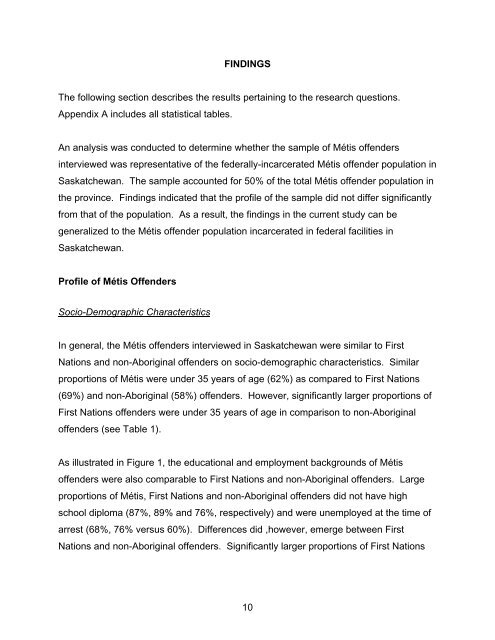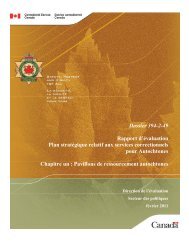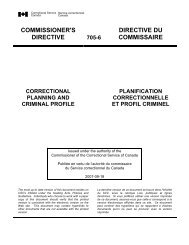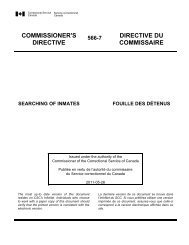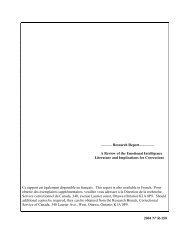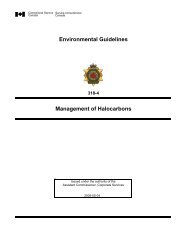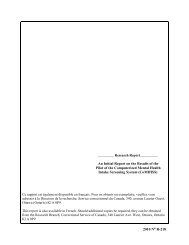Program and Service Needs of Federally Incarcerated Métis ...
Program and Service Needs of Federally Incarcerated Métis ...
Program and Service Needs of Federally Incarcerated Métis ...
Create successful ePaper yourself
Turn your PDF publications into a flip-book with our unique Google optimized e-Paper software.
FINDINGS<br />
The following section describes the results pertaining to the research questions.<br />
Appendix A includes all statistical tables.<br />
An analysis was conducted to determine whether the sample <strong>of</strong> <strong>Métis</strong> <strong>of</strong>fenders<br />
interviewed was representative <strong>of</strong> the federally-incarcerated <strong>Métis</strong> <strong>of</strong>fender population in<br />
Saskatchewan. The sample accounted for 50% <strong>of</strong> the total <strong>Métis</strong> <strong>of</strong>fender population in<br />
the province. Findings indicated that the pr<strong>of</strong>ile <strong>of</strong> the sample did not differ significantly<br />
from that <strong>of</strong> the population. As a result, the findings in the current study can be<br />
generalized to the <strong>Métis</strong> <strong>of</strong>fender population incarcerated in federal facilities in<br />
Saskatchewan.<br />
Pr<strong>of</strong>ile <strong>of</strong> <strong>Métis</strong> Offenders<br />
Socio-Demographic Characteristics<br />
In general, the <strong>Métis</strong> <strong>of</strong>fenders interviewed in Saskatchewan were similar to First<br />
Nations <strong>and</strong> non-Aboriginal <strong>of</strong>fenders on socio-demographic characteristics. Similar<br />
proportions <strong>of</strong> <strong>Métis</strong> were under 35 years <strong>of</strong> age (62%) as compared to First Nations<br />
(69%) <strong>and</strong> non-Aboriginal (58%) <strong>of</strong>fenders. However, significantly larger proportions <strong>of</strong><br />
First Nations <strong>of</strong>fenders were under 35 years <strong>of</strong> age in comparison to non-Aboriginal<br />
<strong>of</strong>fenders (see Table 1).<br />
As illustrated in Figure 1, the educational <strong>and</strong> employment backgrounds <strong>of</strong> <strong>Métis</strong><br />
<strong>of</strong>fenders were also comparable to First Nations <strong>and</strong> non-Aboriginal <strong>of</strong>fenders. Large<br />
proportions <strong>of</strong> <strong>Métis</strong>, First Nations <strong>and</strong> non-Aboriginal <strong>of</strong>fenders did not have high<br />
school diploma (87%, 89% <strong>and</strong> 76%, respectively) <strong>and</strong> were unemployed at the time <strong>of</strong><br />
arrest (68%, 76% versus 60%). Differences did ,however, emerge between First<br />
Nations <strong>and</strong> non-Aboriginal <strong>of</strong>fenders. Significantly larger proportions <strong>of</strong> First Nations<br />
10


